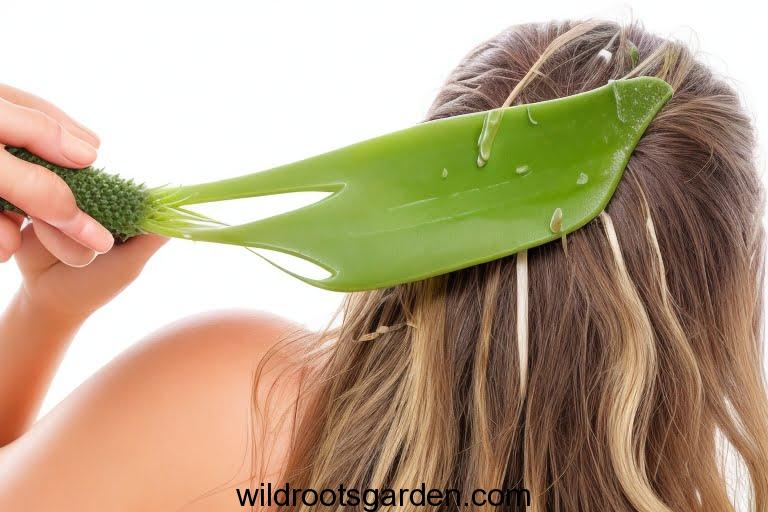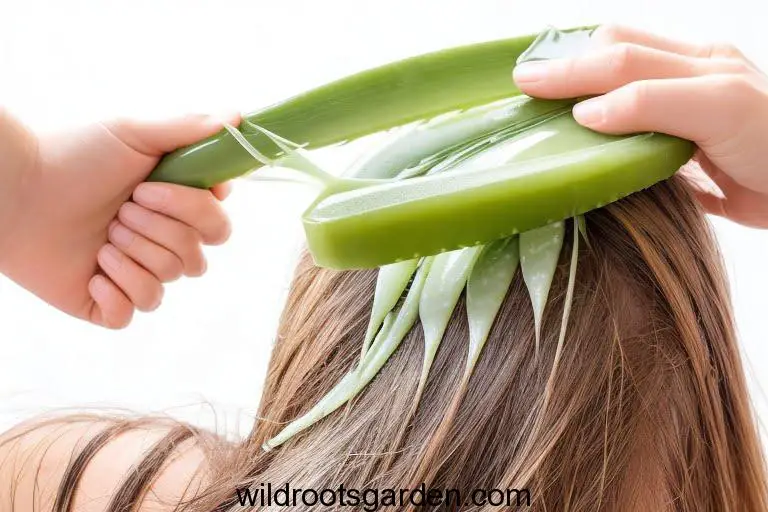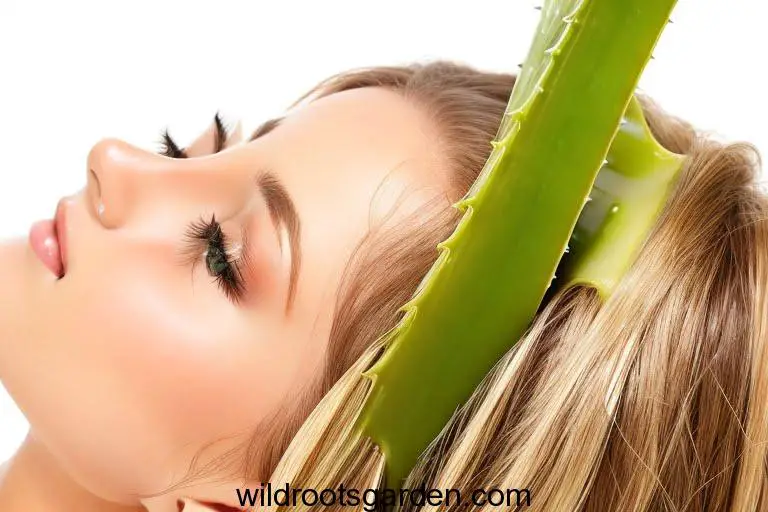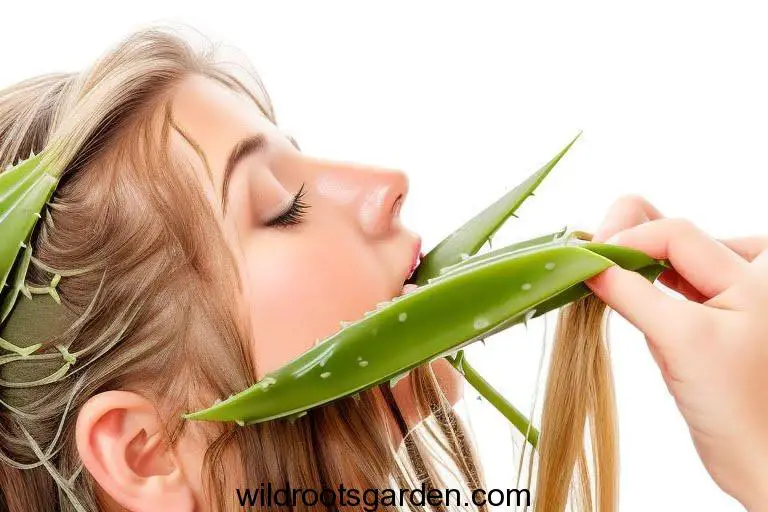The adaptable plant aloe vera has many advantages for both skin and hair care. It’s a common ingredient in many beauty products because of its natural qualities. Aloe vera has drawn interest when it comes to hair because of its potential to nourish, hydrate, and advance general hair health. This article will tell you everything you need to know if you’re wondering whether you can leave aloe vera in your hair.
Table of Contents
Benefits of Aloe Vera for Hair
Let’s first examine the remarkable advantages aloe vera provides for the health of your hair before delving into the debate about whether to leave it in your hair.

Nourishes and Moisturizes
Vitamins, minerals, and amino acids found in abundance in aloe vera can deeply hydrate and nourish your hair. It aids in moisture retention and guards against dryness and brittleness. Your hair may feel softer, smoother, and easier to manage after regular use of aloe vera.
Reduces Dandruff
For many people, having dandruff can be a bothersome and ongoing problem. The antifungal and antibacterial qualities of aloe vera can aid in the fight against dandruff-causing substances. It promotes a healthy scalp environment by calming the scalp, easing itching, and minimizing flakiness.
Promotes Hair Growth
Aloe vera might be a helpful addition to your hair care routine if you’re trying to increase hair growth. It has enzymes that energize hair follicles and encourage hair growth. Aloe vera also aids in restoring the pH equilibrium of the scalp, fostering the ideal conditions for hair development.
Soothes an Itchy Scalp
A scratchy scalp can be irritating. The calming and cooling effects of aloe vera help relieve itching and discomfort. You’ll have a calmer, less inflammatory, and more balanced scalp as a result of its soothing effects.

Can I leave aloe vera in my hair?
Aloe vera can be left in your hair, yes. Letting it sit in your hair for a specific amount of time can optimize its advantages. How to use aloe vera on your hair is as follows:
How to Apply Aloe Vera to Hair
- Get some fresh aloe vera gel or start using an aloe vera hair product.
- To get rid of any filth or buildup, shampoo your hair gently.
- Apply the aloe vera product or gel to your hair, paying special attention to the roots and scalp.
- Use circular motions to gently massage the gel into your scalp.
- Apply the gel evenly throughout the lengths of your hair using your fingers or a comb with large teeth.
- As described in the following section, you should leave the aloe vera in your hair for a particular amount of time.
Duration for Leaving Aloe Vera in Hair
Depending on your preferences and the nature of your hair, you may leave aloe vera in your hair for a different amount of time. Here are some recommendations:
For a quick boost of hydration: you can leave aloe vera in your hair for 15 to 30 minutes before rinsing it out.
For deep conditioning: leave aloe vera in your hair for a longer period, such as 1 to 2 hours. You can cover your hair with a shower cap or towel to enhance absorption.
Overnight treatment: If you’re seeking intense nourishment, consider leaving aloe vera in your hair overnight. Wrap your hair with a soft cloth or use a silk pillowcase to protect your bedding.
Potential Side Effects
Although most people find aloe vera to be generally safe, it’s important to be aware of any adverse effects that could occur, especially if you have sensitive skin or any existing allergies. Mild allergic reactions or scalp irritation may occur in some people. Before using aloe vera on your entire scalp and hair, a patch test is advised. Discontinue use and seek medical advice if you experience any negative effects.

Tips for Using Aloe Vera in Hair
Use the following advice to get the most from aloe vera for your hair:
Choosing the Right Aloe Vera Product
If you decide to use a commercial aloe vera hair product, make sure it has minimal additives and high-quality aloe vera extract. Search for products that have been created especially for hair care and have received favorable user reviews.
Preparing Fresh Aloe Vera Gel
If you prefer using fresh aloe vera gel, follow these steps:
- Cut a mature aloe vera leaf and extract the gel by slicing it open.
- Scoop out the gel using a spoon and transfer it to a clean container.
- Blend the gel to achieve a smooth consistency.
- Use the gel immediately or store it in the refrigerator for up to a week.

Combining Aloe Vera with Other Ingredients
You can enhance the benefits of aloe vera by combining it with other natural ingredients. For example:
- Mix aloe vera gel with coconut oil for added moisturization.
- Add a few drops of essential oils like lavender or rosemary to boost the fragrance and potential benefits.
- Combine aloe vera with honey for a nourishing hair mask.
Conclusion
In conclusion, the nourishing, moisturizing, and relaxing qualities of aloe vera can make it quite useful to leave it in your hair. Whether you like utilizing commercial products or fresh aloe vera gel, it’s crucial to use the right application methods and take into account your hair’s unique requirements. To find the ideal routine, try out various durations and watch how your hair reacts. Appreciate aloe vera’s wonderful advantages for strong, healthy hair!
FAQs
Can I leave aloe vera in my hair overnight?
Indeed, overnight application of aloe vera to the hair can result in significant nourishment. Use a silk pillowcase or wrap your hair to protect your bedding.
Can aloe vera cause hair loss?
Aloe vera does not have a record of causing hair loss. Stimulating the hair follicles can encourage hair growth.
How often should I use aloe vera in my hair?
Aloe vera can be applied to your hair as often as once or twice each week. Depending on the state and response of your hair, change the frequency.
Can aloe vera make my hair greasy?
Aloe vera is airy and typically doesn’t leave a greasy aftertaste. To avoid any buildup, you may wish to thoroughly rinse your hair if it is naturally greasy.
Can I use aloe vera on colored or chemically treated hair?
Yes, you can use aloe vera on colored or chemically treated hair in general without risk. Before using it extensively, it’s usually a good idea to test it on a small area of skin and see how your hair responds.

